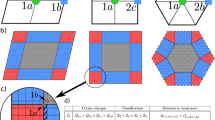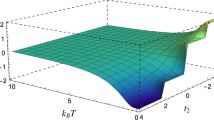Abstract
Frames, or lattices consisting of mass points connected by rigid bonds or central-force springs, are important model constructs that have applications in such diverse fields as structural engineering, architecture and materials science. The difference between the number of bonds and the number of degrees of freedom in these lattices determines the number of their zero-frequency ‘floppy modes’. When these are balanced, the system is on the verge of mechanical instability and is termed isostatic. It has recently been shown that certain extended isostatic lattices exhibit floppy modes localized at their boundary. These boundary modes are insensitive to local perturbations, and seem to have a topological origin, reminiscent of the protected electronic boundary modes that occur in the quantum Hall effect and in topological insulators. Here, we establish the connection between the topological mechanical modes and the topological band theory of electronic systems, and we predict the existence of new topological bulk mechanical phases with distinct boundary modes. We introduce one- and two- dimensional model systems that exemplify this phenomenon.
This is a preview of subscription content, access via your institution
Access options
Subscribe to this journal
Receive 12 print issues and online access
$209.00 per year
only $17.42 per issue
Buy this article
- Purchase on Springer Link
- Instant access to full article PDF
Prices may be subject to local taxes which are calculated during checkout




Similar content being viewed by others
References
Phillips, J. C. Topology of covalent non-crystalline solids 2. medium-range order in chalcogenide alloys and α-Si((Ge). J. Non-Cryst. Solids 43, 37–77 (1981).
Thorpe, M. F. Continuous deformations in random networks. J. Non-Cryst. Solids 57, 355–370 (1983).
Feng, S. & Sen, P. N. Percolation on elastic networks—new exponent and threshold. Phys. Rev. Lett. 52, 216–219 (1984).
Jacobs, D. J. & Thorpe, M. F. Generic rigidity percolation—the pebble game. Phys. Rev. Lett. 75, 4051–4054 (1995).
Liu, A. J. & Nagel, S. R. Nonlinear dynamics—Jamming is not just cool any more. Nature 396, 21–22 (1998).
Liu, A. J. & Nagel, S. R. Granular and jammed materials. Soft Matter 6, 2869–2870 (2010).
Liu, A. J. & Nagel, S. R. The jamming transition and the marginally jammed solid. Annu. Rev. Condens. Matter Phys. 1, 347–369 (2010).
Torquato, S. & Stillinger, F. H. Jammed hard-particle packings: From Kepler to Bernal and beyond. Rev. Mod. Phys. 82, 2633–2672 (2010).
Wyart, M., Nagel, S. R. & Witten, T. A. Geometric origin of excess low-frequency vibrational modes in weakly connected amorphous solids. Europhys. Lett. 72, 486–492 (2005).
Wyart, M. On the rigidity of amorphous solids. Ann. De Phys. 30, 1–96 (2005).
Wilhelm, J. & Frey, E. Elasticity of stiff polymer networks. Phys. Rev. Lett. 91, 108103 (2003).
Heussinger, C. & Frey, E. Floppy modes and nonaffine deformations in random fibre networks. Phys. Rev. Lett. 97, 105501 (2006).
Huisman, L. & Lubensky, T. C. Internal stresses, normal modes and non-affinity in three-dimensional biopolymer networks. Phys. Rev. Lett. 106, 088301 (2011).
Broedersz, C., Mao, X., Lubensky, T. C. & MacKintosh, F. C. Criticality and isostaticity in fibre networks. Nature Phys. 7, 983–988 (2011).
Souslov, A., Liu, A. J. & Lubensky, T. C. Elasticity and response in nearly isostatic periodic lattices. Phys. Rev. Lett. 103, 205503 (2009).
Mao, X. M., Xu, N. & Lubensky, T. C. Soft modes and elasticity of nearly isostatic lattices: Randomness and dissipation. Phys. Rev. Lett. 104, 085504 (2010).
Mao, X. M. & Lubensky, T. C. Coherent potential approximation of random nearly isostatic kagome lattice. Phys. Rev. E 83, 011111 (2011).
Mao, X. M., Stenull, O. & Lubensky, T. C. Elasticity of a filamentous kagome lattice. Phys. Rev. E 87, 042602 (2013).
Kapko, V., Treacy, M. M. J., Thorpe, M. F. & Guest, S. D. On the collapse of locally isostatic networks. Proc. R. Soc. A 465, 3517–3530 (2009).
Maxwell, J. C. On the calculaton of the equilibrium stiffness of frames. Phil. Mag. 27, 294–299 (1865).
Calladine, C. R. Buckminster Fuller’s ‘tensegrity’ structures and clerk Maxwell’s rules for the construction of stiff frames. Int. J. Solids Struct. 14, 161–172 (1978).
Sun, K., Mao, X. & Lubensky, T. C. Surface phonons, elastic response, and conformal invariance in twisted kagome lattices. Proc. Natl Acad. Sci. USA 109, 12369–12374 (2012).
Halperin, B. I. Quantized hall conductance, current-carrying edge states, and the existence of extended states in a two-dimensional disordered potential. Phys. Rev. B 25, 2185–2190 (1982).
Haldane, F. D. M. Model for a quantum hall effect without landau levels—condensed matter realization of the parity anomaly. Phys. Rev. Lett. 61, 2015–2018 (1988).
Kane, C. L. & Mele, E. J. Z(2) topological order and the quantum spin Hall effect. Phys. Rev. Lett. 95, 146802 (2005).
Bernevig, B. A., Hughes, T. L. & Zhang, S-C. Quantum spin hall effect and topological phase transition in HgTe quantum wells. Science 314, 1757–1761 (2006).
Moore, J. E. & Balents, L. Topological invariants of time-reversal-invariant band structures. Phys. Rev. B 75, 121306 (2007).
Fu, L., Kane, C. L. & Mele, E. J. Topological insulators in three dimensions. Phys. Rev. Lett. 98, 106803 (2007).
Hasan, M. Z. & Kane, C. L. Colloquium: Topological insulators. Rev. Mod. Phys. 82, 3045–3067 (2010).
Qi, X-L. & Zhang, S-C. Topological insulators and superconductors. Rev. Mod. Phys. 83, 1057–1110 (2011).
Su, W. P., Schrieffer, J. R. & Heeger, A. J. Solitons in polyacetalene. Phys. Rev. Lett. 42, 1698 (1979).
Nakahara, M. Geometry, Topology and Physics (Hilger, 1990).
Dirac, P. A. M. The quantum theory of the electron. R. Soc. Lond. Proc. A 117, 610–624 (1928).
Witten, E. Dynamical breaking of supersymmetry. Nucl. Phys. B 188, 513–554 (1981).
Cooper, F., Khare, A. & Sukhatme, U. Supersymmetry and quantum mechanics. Phys. Rep. 251, 267–385 (1995).
Schnyder, A. P., Ryu, S., Furusaki, A. & Ludwig, A. W. W. Classification of topological insulators and superconductors in three spatial dimensions. Phys. Rev. B 78, 195125 (2008).
Jackiw, R. & Rebbi, C. Solitons with fermion number 1/2. Phys. Rev. D 13, 3398–3409 (1976).
Volovik, G. E. The Universe in a Helium Droplet (Clarenden, 2003).
Haldane, F. D. M. & Raghu, S. Possible realization of directional optical waveguides in photonic crystals with broken time-reversal symmetry. Phys. Rev. Lett. 100, 013904 (2008).
Wang, Z., Chong, Y. D., Joannopoulos, J. D. & Soljačić, M. Reflection-free one-way edge modes in a gyromagnetic photonic crystal. Phys. Rev. Lett. 100, 013905 (2008).
Prodan, E. & Prodan, C. Topological phonon modes and their role in dynamic instability of microtubules. Phys. Rev. Lett. 103, 248101 (2009).
Berg, N., Joel, K., Koolyk, M. & Prodan, E. Topological phonon modes in filamentary structures. Phys. Rev. E 83, 021913 (2011).
Callias, C. Axial anomalies and index theorems on open spaces. Commun. Math. Phys. 62, 213–234 (1978).
Bott, R. & Seeley, R. Some remarks on paper of callias. Commun. Math. Phys. 62, 235–245 (1978).
Hirayama, M. & Torii, T. fermion fractionalization and index theorem. Prog. Theor. Phys. 68, 1354–1364 (1982).
Niemi, A. J. & Semenoff, G. W. fermion number fractionalization in quantum field theory. Phys. Rep. 135, 99–193 (1986).
Lakes, R. Foam structures with a negative Poisson’s ratio. Science 235, 1038–1040 (1987).
Lawler, M. J. Emergent gauge dynamics of highly frustrated magnets. New J. Phys. 15, 043043 (2013).
Acknowledgements
T.C.L. is grateful for the hospitality of the Newton Institute, where some of this work was carried out. This work was supported in part by a Simons Investigator award to C.L.K. from the Simons Foundation and by the National Science Foundation under DMR-1104707 (T.C.L.) and DMR-0906175 (C.L.K.).
Author information
Authors and Affiliations
Contributions
C.L.K. and T.C.L. contributed to the formulation of the problem, theoretical calculations, and the preparation of the manuscript.
Corresponding author
Ethics declarations
Competing interests
The authors declare no competing financial interests.
Supplementary information
Supplementary Information
Supplementary Information (PDF 417 kb)
Rights and permissions
About this article
Cite this article
Kane, C., Lubensky, T. Topological boundary modes in isostatic lattices. Nature Phys 10, 39–45 (2014). https://doi.org/10.1038/nphys2835
Received:
Accepted:
Published:
Issue Date:
DOI: https://doi.org/10.1038/nphys2835
This article is cited by
-
Nonlinearity-induced topological phase transition characterized by the nonlinear Chern number
Nature Physics (2024)
-
Non-reciprocal topological solitons in active metamaterials
Nature (2024)
-
Realization of photonic p-orbital higher-order topological insulators
eLight (2023)
-
Topolectrical Circuit Correspondence Design of Polyacetylene
Scientific Reports (2023)
-
Non-Abelian effects in dissipative photonic topological lattices
Nature Communications (2023)



